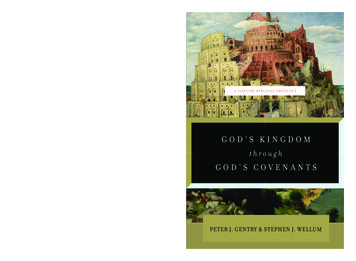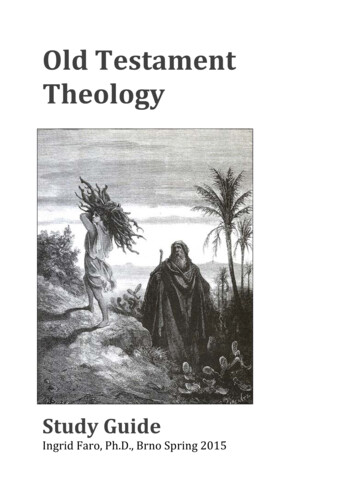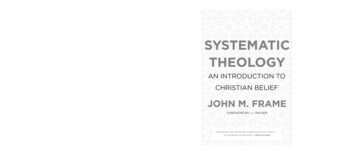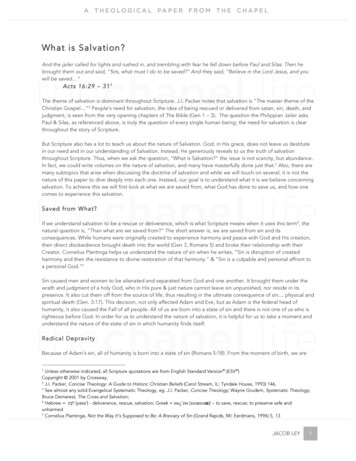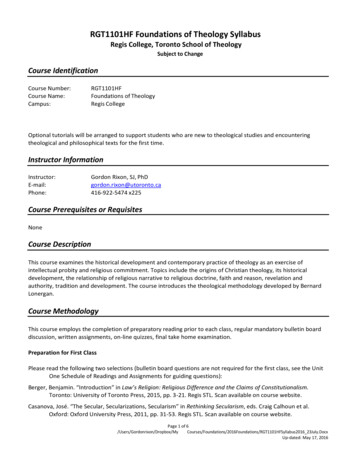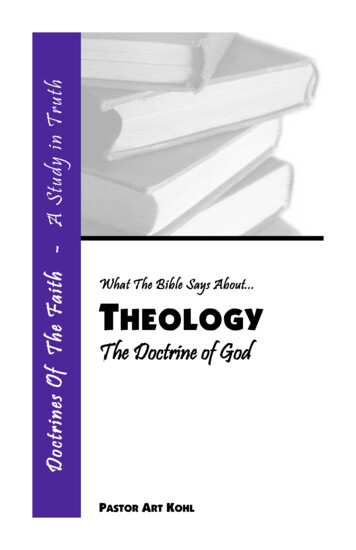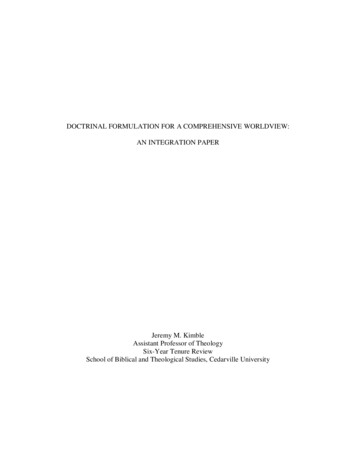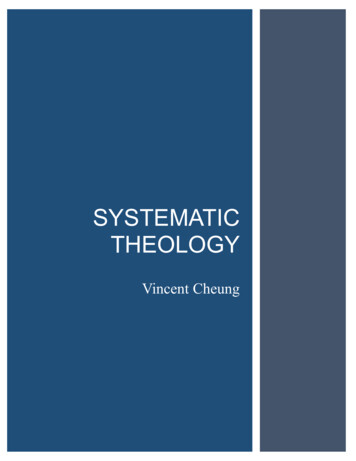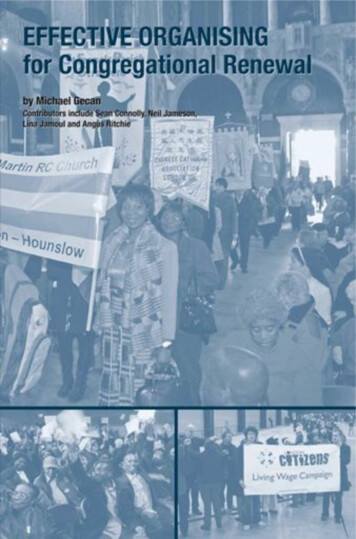
Transcription
BOOKS FROM THE CONTEXTUAL THEOLOGY CENTREPrayer and Prophecy: The Essential Kenneth LeechEdited by David Bunch and Angus Ritchie, with a foreword byAlasdair MacIntyrePublished by Darton, Longman and ToddFaithful Citizens: Catholic Social Teaching and CommunityOrganisingAustin IvereighPublished by Darton, Longman and ToddCrunch Time: A Call to ActionEdited by Angus Ritchie, with contributions by Luke Bretherton,Maurice Glasman, John Milbank and Vincent RougeauPublished by the Contextual Theology Centre
MICHAEL GECANEFFECTIVE ORGANISINGFORCONGREGATIONAL RENEWALby Michael GecanWith contributions fromSean Connolly, Neil Jameson, Lina Jamoul,Amy Lawless, Matt McDermott and Angus RitchieCONTEXTUAL THEOLOGY CENTRE20102
3EFFECTIVE ORGANISING FOR CONGREGATIONAL RENEWALEFFECTIVE ORGANISING FORCONGREGATIONAL RENEWALby Michael GecanEdited by Gregory F. Augustine Pierce and Liliana WorthCover and text design by Chris JepsonPart I 2008 Michael GecanPart II chapters 2010 the AuthorsPublishing facilitated byThe Contextual Theology CentreThe Royal Foundation of St. Katharine, 2 Butcher Row, London E148DSwww.theology-centre.orgAll rights reserved. No part of this publication may be reproduced ortransmitted in any form or by any means, electronic or mechanical,including photocopying and recording, or by any information storageand retrieval system, including the Internet, without permission fromthe publisher. Permission is hereby given to use short excerpts orpieces of art with proper citation in reviews and marketing copy, churchbulletins and handouts, and scholarly papers.
MICHAEL GECANCONTENTSPART I: THE TOOLSIntroduction5Individual Meetings7Power (Relational) Analysis13Teaching and Training21Action and Evaluation24Getting Started33PART II: THE EXAMPLESA Catholic Organising Story37A Muslim Organising Story42A Protestant Organising Story47A Jewish Organising Story51An Anglican Organising Story564
5EFFECTIVE ORGANISING FOR CONGREGATIONAL RENEWALPART I: THE TOOLSALL ORGANISING IS DIS-ORGANISING AND RE-ORGANISINGMichael GecanMetro Industrial Areas FoundationYour congregation – be it Catholic or Protestant, Jewish orMuslim, Buddhist or Bahá’í – has been around a while.You may have had only one or two clergy leaders, or youmay have had many. Like all organisations, you havefallen into certain patterns of operation, some good andsome not. Again like all organisations, you have twochoices: to continue to do what you always have done(because that’s the way you do things) or to reorganize(and thereby re-energize) the way you do business.If you want to reorganize, the tools used for over fiftyyears by the organizations under the umbrella of theIndustrial Areas Foundation, can help.Years ago, we were conducting a training session for agroup of leaders in one of our most effective andsuccessful citizens’ organisations. The training focused onone of the most basic skills of any kind of organising: howto organise and conduct a productive meeting in one hour
MICHAEL GECAN6or less. Running good meetings has long been the practicewithin our organisations, but it became a hallmark of ourorganisations because we kept teaching and re-teachingpeople how to do it until it finally became second natureto them.In the course of the session, one of the leaders asked whythe same people who conducted and participated ininteresting, useful, and productive meetings in the contextof citizens’ organising tolerated other meetings back intheir congregations that often lasted three or more hours,were not well-planned, and often led to little action orprogress.We began to get more requests from rabbis, imams,pastors and lay leadership groups in congregations toteach them how to use the same tools that worked incitizens’ organisations within the context of theircongregations. So, approximately 20 years ago in theUnited States and more recently in the United Kingdom,we started to develop training programs that weredirectly aimed at congregational development. We beganwith how to run more effective meetings and broadenedour work from there. Today, we spend a significantamount of our time – in congregations of all faiths anddenominations and in several seminaries – describingwhat we believe are the four universal tools of all effectiveorganising and how the understanding of those tools anduse of those tools can contribute to the daily life ofcongregations.
7EFFECTIVE ORGANISING FOR CONGREGATIONAL RENEWALWe will describe each of these tools and suggest how theycan be used by leaders of local mosques, synagogues,congregations, parishes and other local religiousinstitutions. Then we include several short examples –case studies, if you will – from our work about how thesemethods worked in specific congregations from differentfaiths.The four tools are:I Individual MeetingsThese are by far the most important, effective, and leastused organisational tool in congregational life today.II Power (Relational) AnalysisPower analysis both of the institution and the broadercommunity in which congregations find themselves.III Teaching and TrainingThese are used sometimes and somewhat in somecongregations, but too narrowly and ineffectively.IV Action and EvaluationThese are also used in congregations, for example inliturgy training, but again too narrowly and without acommitment to the development of congregationalleaders.IIndividual Meetings
MICHAEL GECAN8An individual meeting is a face-to-face, one-to-onemeeting in someone’s home, apartment, workplace orlocal coffee shop which takes about 30 minutes. Thepurpose of the meeting is not chitchat, whining, selling,gossip, sports talk, data collection, or therapy. The aim ofthe meeting is to initiate a public relationship withanother person. This may seem so basic and oldfashioned that many of you are wondering what we aretalking about here. We are suggesting an approach toothers that Dietrich Bonhoeffer, the great Lutherantheologian, described in this way: “The first service thatone owes to others in the fellowship consists in listeningto them Those who cannot listen long and patiently willalways be talking past others, and finally will no longereven notice it The death of the spiritual life starts here Brotherly pastoral care is distinguished from preaching by the obligation of listening.”If the death of the spiritual life starts in “talking pastothers” so frequently that you “finally will no longer evennotice it,” then the birth of the spiritual life starts in theindividual, one-on-one meeting – in listening to the otherperson.Face-to-face meetings are the truly radical acts of effectiveorganising. They are not a slogan or a demonstration; notan email blitz or power point presentation. Thecommitment to listening to others means that the leaderswho initiate them operate on the basis of severalimportant assumptions.
9EFFECTIVE ORGANISING FOR CONGREGATIONAL RENEWALThe first assumption is that the other person is worthlistening to. The late British philosopher, Bernard Crick,described this as having a belief in the affirmativeindividual – that most people, most of the time, will do theright thing, if given the opportunity. So the very act ofcalling someone up and setting up an individual meetingwith them, of going to their home or meeting them at acoffee shop and listening to them, of asking them whatthey think about the community or congregation orcountry, understanding how they see the future, hearingwhat hopes and dreams they have, learning where they’vecome from and how they see themselves five years in thefuture, is an act of recognition. You are saying to the otherperson: you have values, ideas, dreams, plans, lessons,insights that are well worth listening to.Recognition is the pre-condition for any ongoing reciprocalworking relationship with others. When August Gecan (thelate father of one of the authors) arrived in the UnitedStates in the 1930's, a teenager from the coast of Croatia,the local parish priest in the Croatian parish in Chicagowent to his apartment and did an individual meeting withhim. Then, every year, for 60 years, that priest and hissuccessors paid a yearly visit to the Gecan home, to visitwith him and to bless the house. This was a banner day inAugust Gecan's year. The priest was recognising him,listening to him, and bringing the incense and holy waterfrom the church to him. Those priests demonstrated thatthey believed that he – bartender, plasterer, security guard,working man – was worth visiting and hearing out. In
MICHAEL GECAN10Christian language, this is how the priests demonstratedthat they believed that he was made in the image andlikeness of God.The second assumption is that the person initiating theindividual meeting – organiser, pastor, veteran leader –understands that the time devoted to individual meetingsis more important than time spent in more conventionalactivities. “All real living,” said theologian Martin Buber,“is meeting.” The initiator knows that the new dynamiccreated by meeting and relating to another person is richwith opportunity and possibility. The congregation isn’tmostly in the building or staff or programs already inplace. The congregation isn’t in the head of the leader orin the mannerisms of the hierarchy. The congregationlives and grows in the interaction between existing andnew leaders and members – in the very act of doing theindividual meeting.When a young assistant rabbi arrived in his newcongregation, he started his ministry by doing nearly 100individual meetings. He also sat in on many other meetingsand activities. But the action that told him the most aboutthe congregation – and told the congregation the mostabout him – was the fact that he had spent 100 evenings intheir homes and apartments, meeting face to face and oneto one. He knew his congregants, and they knew him, muchbetter after three months than many congregations knowtheir new staff after several years. His sermons were spoken
11EFFECTIVE ORGANISING FOR CONGREGATIONAL RENEWALto people’s specific struggles and concerns, not to somegeneric congregation in some generic place. It’s not that heused anyone’s name in his talks. He didn’t need to. Peopleheard him talking directly to them, based on what he hadabsorbed in his initial round of individual meetings. Hewasn’t talking past others. He was talking to them and withthem.The third assumption, hinted at in the act of doingindividual meetings but only proven over time, is that thecorporate identity of the congregation remains information; that the newest member, the most recentarrival, is invited to join in the ongoing creation of theevolving local community. The relationship is not oneway, unilateral, provider-to-consumer, but two-way,reciprocal, and mutual. This assumption is easier toconvey when the congregation is relatively new, when itis in the first 30 or more years of its existence. Theexplosion of new evangelical churches in the past threedecades is in part a product of the burst of energy thatsometimes occurs when an institution is born and beginsto grow at a rapid rate. More than 1,200 such churches,some as large as small American cities, have formed anddeveloped during this period. The challenge to them nowwill be to maintain the sense of experimentation andoutreach that characterized their early years. Thetendency to mature – that is, to become morebureaucratic and programmatic, to become formed, fixed,and no longer in need of large numbers of new members–will tempt these congregations as it has more mainlinereligious bodies over the centuries.
MICHAEL GECAN12Several years ago, leaders working in a soup kitchen in aLong Island parish incorporated into their mission the habitof doing individual meetings with their clients. Instead ofsimply handing a sandwich to the men who came to thekitchen, they sat down with them and asked them who theywere, where they were from, what line of work they hadbeen in, and why they were there. They listened, long andpatiently, day after day, and they heard a story, repeated bymany men, that they had never heard before. Many of thesemen lived in small group homes called “sober houses.” Theywere supposed to be places where people in recovery fromsubstance abuse could reside, so that they could receivedaily outpatient services from area treatment centres. Inreality, many of these sober houses were poorly run, riddledwith drugs, and exploited by the companies that managedthem. One was run by a company that had preyed on othervulnerable populations in other states and had beenexposed in those states, but had simply moved to LongIsland and exploited a new group. Another sober house wasrun by an operator with mob connections. The food in manyof these places was terrible; hence the trip to the church’ssoup kitchen. These were middle class men, mostly white,who had been professionals and skilled workers beforebecoming addicted to alcohol or drugs. In the process oforganizing, the volunteers in this soup kitchen, one paidcommunity organizer named Michael Stanley, and otherinterested volunteer leaders in the parish did more than600 individual meetings. A team of leaders, most inrecovery themselves, formed. In-depth research led to aneffort to expose the bad sober house operators and clean up
13EFFECTIVE ORGANISING FOR CONGREGATIONAL RENEWALconditions in them. This successful social justice effortstarted in the act of listening, person to person, in a parishbasement, by volunteers who valued the opportunity todevelop new public relationships as much as the chance todeliver a healthy meal to hungry and isolated men.These three assumptions are what ideologues, advocates,and program directors have long forgotten, if they everconsidered them. The ideologue, left or right, knows allthe answers and wants the rest of the world to fall in line,to swallow whole the “correct” analysis or platform ordoctrine, and to parrot back the party line. The advocateknows all the answers too, and wants to speak for others,rather than listen to others and wait for others to developthe ability and skill to voice their own concerns. And theprogram director wants to deliver the service or food orclothing or housing voucher without getting to know theperson who is seeking help, without asking what otheraspects of that person’s life are working or have worked,without challenging that person to do as much for himselfor herself as humanly possible.IIPower (relational) analysisMany leaders of congregations operate without a clearand honest picture of the relational terrain in which theyfunction – both inside the congregation and with thesurrounding community. A basic understanding of whichleaders have followings and influence, how they relate to
MICHAEL GECAN14one another, who determines what decisions are madeand how money is spent is what we call a power orrelational analysis. At bottom, a power analysis is arelational map of the way an institution really functionsand how that institution actually interacts with otherinstitutions in the real world.Not to have this map – objective, visible, changing asrelationships change – is an invitation to get lost and staylost. For example, in some mosques, the Imam is both thespiritual and operational leader. There may be a board,and the Imam may relate to it in various ways, but he’sclearly in charge. If you want to work well with thisparticular mosque, you had better understand this andfigure out how to respect the Imam and relate to andthrough him. In another mosque, however, while theImam may be the spiritual leader, the lay president of theboard may be the operational leader, and three or fourkey members of the board may be the key supporters ofthe president. In that case, obviously, a relationship withthe president is critical to any effort to operate within themosque, even though showing respect for the spiritualrole of the Imam would still be important.In black church settings, some congregations are what wecall “pastors’ churches,” some are “deacons’ churches,”while still others are steered by several lay families withdeep followings in the community. If you don’t knowwhich is which, whether you are a member of thatparticular congregation or an outsider trying to work withit, you are doomed to failure.
15EFFECTIVE ORGANISING FOR CONGREGATIONAL RENEWALIn some places, the local Episcopal or Anglican diocese isconsidered quite progressive. In other regions, the stanceof the diocese may be quite conservative or traditional. Inyet other places, there is a mix of these orientations –either a healthy respect for differing views or a simmeringtension and tone of hostility.Very similar analyses of all churches, synagogues,mosques, temples, and other religious institutions can andmust be made if you are going to try to work with them –either internally or externally.Instead of doing such power analysis, however, manywould-be agents of change operate on the basis of theirown preconceptions of how institutions should function.Or they engage in wishful thinking. Or they accept thestereotypes or abstractions peddled by others, includingthe leaders of the very congregations they are trying toorganize. In our parlance, these people remain in theworld as they think it should be, rather than taking thetime and investing the energy to decipher how acongregation operates at this particular time, in thisparticular place, in the world as it is right now.In New York City, residents had long been told that the wayto get things done was to take concerns to local communityboards. There were about 100 of these, and they weredominated by local city council people and boroughpresidents and funded by the city. Metro IAF leaders in NewYork did an analysis of the city’s political structure and
MICHAEL GECAN16budget process, and it quickly became clear that the mayorcontrolled about 96% of the city budget, leaving only about4% in the hands of the city council and their hand-pickedcommunity boards. That meant each community board had,at best, some influence over 1/100th of 4% of the budget –about 24 million each out of a total budget of 60 billion, arelative pittance. So the leaders refused to focus on thecommunity boards or city council people. In fact, the sevenlocal leaders of community boards who were members oflocal Metro IAF congregations publicly resigned. Theyannounced that they would now be doing public business ina different way. And that way was to relate directly withthe mayor, who was extremely strong in the New Yorkpolitical culture, who appointed the commissioners whomanaged billion-dollar agencies, and who controlledapproximately 57 of the 60 billion spent each year by thecity. This analysis and subsequent action, of course,agitated the community-board types, the foundationofficers who had urged countless community groups tofollow this dead-end approach, and every local electedofficial. The less power these individuals actually had, themore desperate they were to convince others that they wereimportant. They positioned themselves as gatekeepers tothe power brokers. They pretended to be frantically busy.They sent junior aides out to meet with local communitygroups because they were “tied up at City Hall.” (Yearslater, in a local community school board office, Metro IAFleaders found their desks packed with important papers –menus from local restaurants and little else.) The poweranalysis also put a new form of pressure on localcongregations and congregationally-based organisations.
17EFFECTIVE ORGANISING FOR CONGREGATIONAL RENEWALThe challenge was clear: how to get into a productive,public, working relationship with the mayor and his keyappointees. This is not a simple or easy matter in a city ofeight million people with scores of powerful interests – realestate, finance, union, development, advertising, legal andothers. But at least that challenge, if met, leads to realreaction, real response, and real results.How does such a power or relational analysis get done bya congregation? The first answer is: very carefully. Thereare egos to be assuaged, ancient grievances and hurts tobe understood and either buried or ignored, and tons ofspin to be un-spun.The first rule is that the analysis is done with and by theleaders of the congregation themselves. It is not anoutside critique as much as an inside admission of theway things operate, both inside the congregation and visà-vis the “outside” world.Second, a power analysis of a congregation can only bedone after a serious and sustained series of individualmeetings. Until trust is developed between and amongmembers of the congregation, no one is going to open upabout how the congregation really operates. In fact,everyone will claim that it functions exactly the way itsays it functions in the congregational by-laws orliterature. (This is almost never the case, but it is a myththat many congregations try to peddle to outsiders andeven to their own members.) So, a power analysis of a
MICHAEL GECAN18congregation is based on trust relationships that havebeen developed over a period of time through asystematic series of one-on-one interviews.If you are working in the Chicago area, it’s important toknow that the relationship between the mayor and localaldermen is different from the one in New York and othercities. In Chicago, the mayor has enormous power. But theDaley Dynasty (pater et fils) has an unwritten agreementwith the city’s aldermen: the mayor gets to control alldowntown and other major development (like O’HareAirport, the convention centre, Navy Pier, sports arenas,etc.) while the aldermen get veto power over all localdevelopment in their wards (at least those that the mayordoesn’t care about). The aldermen, in effect, are minimayors in their wards. In New York, four successive mayorshave used their power to rebuild neighbourhoods with localnot-for-profit groups, even when these changes wereopposed by local politicians. In Chicago, however, theunwritten agreement between mayor and aldermenprohibits that. The mini-mayors control all contracts andpay-offs in their wards, and as a result they have let theircommunities crumble while lining their own pockets.Frequently, they have ended up indicted, convicted, and injail. The mayor then appoints another alderman, and thecycle starts all over again. This is not a rationale for thepeople of Chicago to accept this arrangement, but it iscritical that they understand it. Only then can they contendwith, confront, or alter it.
19EFFECTIVE ORGANISING FOR CONGREGATIONAL RENEWALIn the United Kingdom, the City and Corporation of London(often called the Square Mile) has its own political cultureand dynamics quite different from the historic and vibrantLondon, which is the official capital of London. Thethousands of tourist and most of the 8m residents of thegreater London area, in their 33 local authorities aremostly oblivious to the power and roots of the smallest(8,000 residents) but most powerful local authority in theland – the City and Corporation of London, the historicfounder of modern day capitalism. The City of London cantrace its roots back to the Romans in 47AD and developedas the commercial and financial centre of the world in1066. Its boundaries within London have not changed orbeen threatened since then. CITIZENS UK helped built theUK’s first broad based organization – The East LondonCommunities Organisation (TELCO) in 1996. Ten yearslater with the use of the core organising tools described inthis book, TELCO had grown into London Citizens and had120 member communities in 16 London Boroughs. In 1998an elected Mayor of London was introduced by the newLabour Government providing a focus for well organisedcommunities to relate to, meet with and do business.London Citizens focused much of their cross London intereston cementing a working relationship with whoever was theelected Mayor, holding Accountability Assemblies for themain candidates in 2000, 2004 and 2008 (when theConservative Boris Johnson defeated the seating Labourcandidate, Ken Livingston). The world financial crisis of2008 encouraged Citizens to do a fresh and broader poweranalysis of not just the machinery of government but the
MICHAEL GECAN20role of the banks and finance houses as well. We turned tosome of the academics in our membership and were helpedconsiderably by Drs Luke Bretherton and Maurice Glasmanto focus on the power and pervasiveness of organisedmoney – epitomised by the City and Corporation of London.We held regular walking tours of the Square Mile, visitedthe ancient parliament of the City – The Guildhall; studiedthe Guilds and understood more about the link between theglobal banks located in the Square Mile and theCorporations own feudal system of governance. As the UKgovernment ploughed 1.2 trillion into saving the BankingSystem from collapse London Citizens appealed to theformal head of the Corporation, Lord Mayor, Alderman NickAnstee for the one thing we believed we needed above allothers – a working relationship. At a time of crisis in May2009, 30 key leaders from London Citizens met for arelational summit in The Mansion House (Lord Mayor’sOfficial Residence) with the Lord Mayor, the Sheriff andanother 20 heads of Banks and Finance Houses to start theslow and patient process of trying to understand eachother’s interest. Simultaneously Citizens membercommunities were holding house meetings and one to oneson the theme of ‘How has the financial crisis affected youand your family?’ On November 25th of that year thisprocess of power analysis, relational one to ones andbuilding power led to London Citizens leaders booking theCorporation’s own Assembly Hall, in the heart of the SquareMile to hold an Assembly of 2,000 citizens with MayorJohnson, major bankers and politicians and keyrepresentatives of The City and Corporation of London – toLaunch The Citizens 5 Point Response to the Economic
21EFFECTIVE ORGANISING FOR CONGREGATIONAL RENEWALCrisis – calling for Living Wage, Cap on Credit,Transparency in Banking, Investment in CommunityBanking and a new relationship between organised people(Citizens) and organised money.Third, a power analysis of a congregation is not written inink, not plastered on a wall for permanent viewing, not putinto a power point presentation for the world to see. It issketched in pencil, revisited regularly, and edited on anongoing basis. There are good reasons for this. A poweranalysis is a very fluid thing, changing month to month,week to week, even day to day at times. To try to freeze itin time is not only impossible but also counterproductive,because a frozen power analysis is almost worse than nopower analysis at all. Relationships change, both inside thecongregation and with the outer world. The key is to keepobserving, refining, and adding to an ongoingunderstanding of how the congregation really works. Apower analysis of a congregation is primarily a tool for theleaders of the congregation and for others whose judgmentand advice is sought and respected by those leaders. It is atool for “disorganising and reorganising” the congregationby its own leaders and friends and colleagues – nothingmore, nothing less.IIITeaching and TrainingAlmost every religious institution takes seriously the taskof teaching its members about doctrines and traditions.But very few congregations take the time to instruct its
MICHAEL GECAN22members about how to master the basic tools ofleadership in the institution itself. In the Roman Catholicsetting, for example, there is the Rite of ChristianInitiation of Adults (RCIA), which prepares someoneseeking to join the church with an understanding of basictenets and beliefs. But there is no Rite of LeadershipInitiation of Adults (RLIA).What skills does a potential adult leader need to learn tooperate as effectively as possible in a congregation? Inalmost every congregation, we organisers hear peopleexpress concern about the lack of growth or the persistentloss of members, but in those congregations no one isbeing taught how to initiate and create meaningful publicrelationships with existing and potential congregationalmembers.In many congregations, we hear worries about too fewleaders doing too much work, but in the vast majority ofthose congregations, no one is taught how to mentor,support, and challenge new leaders. There is no clearrecruitment or training process for new leaders. And littleor no money is budgeted for this teaching and training. Itis all left to chance, or often ignored completely.In other congregations, there is anxiety about how toengage younger people. But in those congregations, thereis no systematic outreach to specific young people. No onesits down with them one to one. No one listens to themperson to person. No one challenges them to operate likethe adults they already are, or soon will be, inside theinstitution or in the world. Instead, we try to guess what
23EFFECTIVE ORGANISING FOR CONGREGATIONAL RENEWALyoung adults might enjoy – going to a ballgame, listeningto music, playing basketball in the gym? – and then designevents we hope will appeal to them. (This strategy, by theway, almost always fails miserably.)In a stable and active Presbyterian church in centralQueens, the pastor, Reverend Patrick O’Connor, asked leadorganizer Ojeda Hall-Phillips and me to do a session withabout 20 of the main leaders there. The church is solid. Thepastor is talented and focused. The staff works hard. Theactivities are well run. Although it is one of the bestattended Presbyte
Published by the Contextual Theology Centre . MICHAEL GECAN 2 EFFECTIVE ORGANISING FOR CONGREGATIONAL RENEWAL by Michael Gecan With contributions from Sean Connolly, Neil Jameson, Lina Jamoul, Amy Lawless, Matt McDermott and Angus Ritchie CONTEXTUAL THEOLOGY

